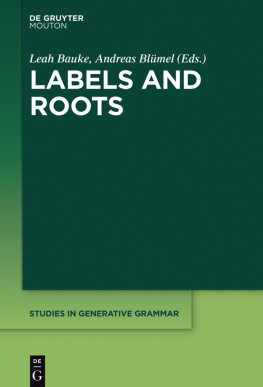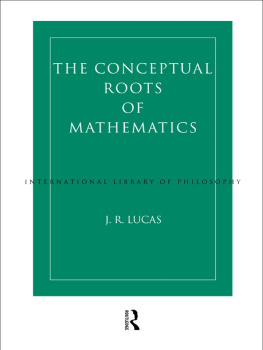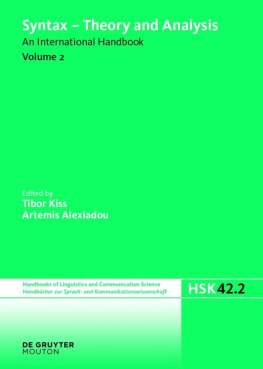Bauke Leah S. - Labels and roots
Here you can read online Bauke Leah S. - Labels and roots full text of the book (entire story) in english for free. Download pdf and epub, get meaning, cover and reviews about this ebook. year: 2017, publisher: De Gruyter Mouton, genre: Romance novel. Description of the work, (preface) as well as reviews are available. Best literature library LitArk.com created for fans of good reading and offers a wide selection of genres:
Romance novel
Science fiction
Adventure
Detective
Science
History
Home and family
Prose
Art
Politics
Computer
Non-fiction
Religion
Business
Children
Humor
Choose a favorite category and find really read worthwhile books. Enjoy immersion in the world of imagination, feel the emotions of the characters or learn something new for yourself, make an fascinating discovery.
- Book:Labels and roots
- Author:
- Publisher:De Gruyter Mouton
- Genre:
- Year:2017
- Rating:3 / 5
- Favourites:Add to favourites
- Your mark:
- 60
- 1
- 2
- 3
- 4
- 5
Labels and roots: summary, description and annotation
We offer to read an annotation, description, summary or preface (depends on what the author of the book "Labels and roots" wrote himself). If you haven't found the necessary information about the book — write in the comments, we will try to find it.
Labels and roots — read online for free the complete book (whole text) full work
Below is the text of the book, divided by pages. System saving the place of the last page read, allows you to conveniently read the book "Labels and roots" online for free, without having to search again every time where you left off. Put a bookmark, and you can go to the page where you finished reading at any time.
Font size:
Interval:
Bookmark:

Leah Bauke and Andreas Blmel (Eds.)
Labels and Roots
Studies in Generative Grammar

Editors
Norbert Corver
Harry van der Hulst
Roumyana Pancheva
Founding editors
Jan Koster
Henk van Riemsdijk
Volume 128

ISBN 978-1-5015-1058-8
e-ISBN (PDF) 978-1-5015-0211-8
e-ISBN (EPUB) 978-1-5015-0213-2
ISSN 0167-4331
Library of Congress Cataloging-in-Publication Data
A CIP catalog record for this book has been applied for at the Library of Congress.
Bibliographic information published by the Deutsche Nationalbibliothek
The Deutsche Nationalbibliothek lists this publication in the Deutsche Nationalbibliografie; detailed bibliographic data are available on the Internet at http://dnb.dnb.de.
2017 Walter de Gruyter, Inc., Boston/Berlin
www.degruyter.com
Artemis Alexiadou
Humboldt Universitt zu Berlin
Leah S Bauke
Bergische Universitt Wuppertal
Petr Biskup
Universitt Leipzig
Andreas Blmel
Georg-August-Universitt Gttingen
Chris Collins
New York University
Samuel David Epstein
University of Michigan
Hisatsugu Kitahara
Keio University
Terje Lohndal
Norwegian University of Science and Technology
UiT The Arctic University of Norway
Miki Obata
Hosei University
Dennis Ott
University of Ottawa
Tom Roeper
University of Massachusetts Amherst
T. Daniel Seely
Eastern Michigan University
Michelle Sheehan
Anglia Ruskin University
Aleksandra Vercauteren
Ghent University
In syntactic and morphological theory, complex structures are assumed to be composed of subparts: A = [B C]. If one member of A is a lexical item and contributes to its distribution, its interactions with other objects, etc., we can refer to this member as As head . Recent approaches (Collins 2002, Chomsky 2013, 2015) seek to derive endocentricity of phrases (Chomsky 1970, 1986; Jackendoff 1977) by a general labeling algorithm, delving more deeply into the role syntactic category values ( v , n , C, T, etc.) play in syntax and in interpretation. A related branch of research attempts to determine semantic and syntactic contributions lexical categories make for the combinatorial system, as in the study of argument structure. How do we account for the morphosyntactic behavior of root elements, and what role do labels play in their behavior? In the exoskeletal approach to syntax (Borer 2005a, 2005b et seq , De Belder 2011), lexical roots have no intrinsic categorial label: rather, the syntactic configuration in which a root is found determines its category and its specific semantic contribution. Distributive Morphology approaches (Marantz 1997 et seq ) similarly argue that categorial functional heads determine the category of roots they merge with (cf. a.o. Arad 2003, 2005).
The workshop Labels and Roots, which took place at the conference of the German linguistic society (Deutsche Gesellschaft fr Sprachwissenschaft) in 2014, aimed at addressing issues surrounding the above topics and sought to bring together a variety of syntactic and morphological research whose focus is on empirical and conceptual arguments (in any and all current theoretical frameworks) concerning fundamental questions regarding labeling/endocentricity and roots, both to assess the state of the art in the field, and to inspire further research. The papers contributed for real were mostly minimalist, broadly construed. Most papers in this volume stem from this inspiring workshop and address some key questions:
- What work do syntactic labels do, within the syntax and morphology, and for semantics and phonology?
- What is the possible content of a label? Is the content drawn from one or both parts of a complex object?
- How generally predictable are labels?
- Are labels components of a structure, or determined by a labeling procedure (Boeckx 2009, Chomsky 2008, 2013), or can they be outsourced completely from the syntax (Adger 2013)?
- Do lexical roots have morpho-syntactic features which serve as their labels (Harley, 2014), or are their syntactic/morphological categories provided by formal elements with which they combine (Marantz 2008, Irwin 2012)?
- How might labeling be involved in more diverse syntactic phenomena, such as Agreement, Case, movement, and so on?
The following considerations regarding how categorial and/or featural information of the most prominent lexical item in a given phrase comes about encompass major steps in the development of headedness in generative grammar. While most papers in this volume addressing labels directly or indirectly touch on Chomsky 2013, 2015, some pursue alternative conceptions altogether.
Labelling has been a prominent concept in syntax ever since the formulation of the Standard Theory (Chomsky 1965). Labels are the key conceptual address in any phrase structure rule formulated at this time. However, the nature of labels is hardly ever scrutinized then. Labels exist by mere stipulation and similarly the distinction between a well-formed phrase-structure rule of the type VP V NP and a phrase-structure rule of the kind PP V NP, which derives ungrammatical structures, is based on stipulation. To this present day, the introduction of X-theory in Remarks on Nominalization (Chomsky 1970) is celebrated as one of the hallmarks of generative syntax that finally remedied this unfortunate affair. Phrase structure rules that did neither derive all nor only the grammatical sentences of a language and thus failed to meet the key criterion for any theory of generative grammar were abandoned and replaced by X-structures. So the numerous phrase structure rules of old were replaced by one uniform schema: XP X (YP) and X X (ZP). Along the way, labelling was not so arbitrary and stipulative any more, the assumption that heads are the endocentric core of all structures, which in turn emerge from projection, provided a clear role for labels, which are likewise percolated along the projection line from the endocentric head. This did not solve the question of how labels are created but it provided a mechanistic purpose to labelling that was completely syntax internal. For the interfaces, the role of labelling still played virtually no role. In minimalist syntax the role of labels changed once again. Also this time, the change did not come about by questioning the status of labels per se, instead it was again a consequence of a conceptual change in how syntactic derivation proceeds that also affected the status of labels. In bare phrase structure syntax all derivations are characterized by recursive application of Merge, either external or internal, which is a set-creating operation. Hence, X-theoretic conceptions of structure building are replaced by operations of set-formation of the type Merge (, ) {, } = . The question of labelling here resurfaces (in the form of how does receive a label) and is more imminent than it has ever been before. Basically two answers are provided. The first is still based on projection ideas that are imported from X-theory according to which the label of is determined by simple projection of the label of either or and thus e.g.: = {LB(), {, }}. Here, projection is not only a part of the syntactic operation itself, but the label is crucially represented in the syntactic structure. Alternatively, labelling is determined by a third factor principle, Minimal Search : In any syntactic structure derived by recursive application of Merge that forms a set consisting of a lexical item and a (complex) syntactic object, the lexical item will provide the label (cf. Chomsky 2004, 2008, 2013, 2015). Hence: Merge (Head, XP) {Head, XP} = HeadP. From this point of view and in contrast to projectionist conceptions, the label is crucially not part of the syntactic representation . For further elucidation of the historical development of the theoretical stages and for detailed description of this recent approach, we refer the reader to the contributions by Epstein: Kitahara and Seely (henceforth EKS), Collins and other papers in this volume.
Font size:
Interval:
Bookmark:
Similar books «Labels and roots»
Look at similar books to Labels and roots. We have selected literature similar in name and meaning in the hope of providing readers with more options to find new, interesting, not yet read works.
Discussion, reviews of the book Labels and roots and just readers' own opinions. Leave your comments, write what you think about the work, its meaning or the main characters. Specify what exactly you liked and what you didn't like, and why you think so.











